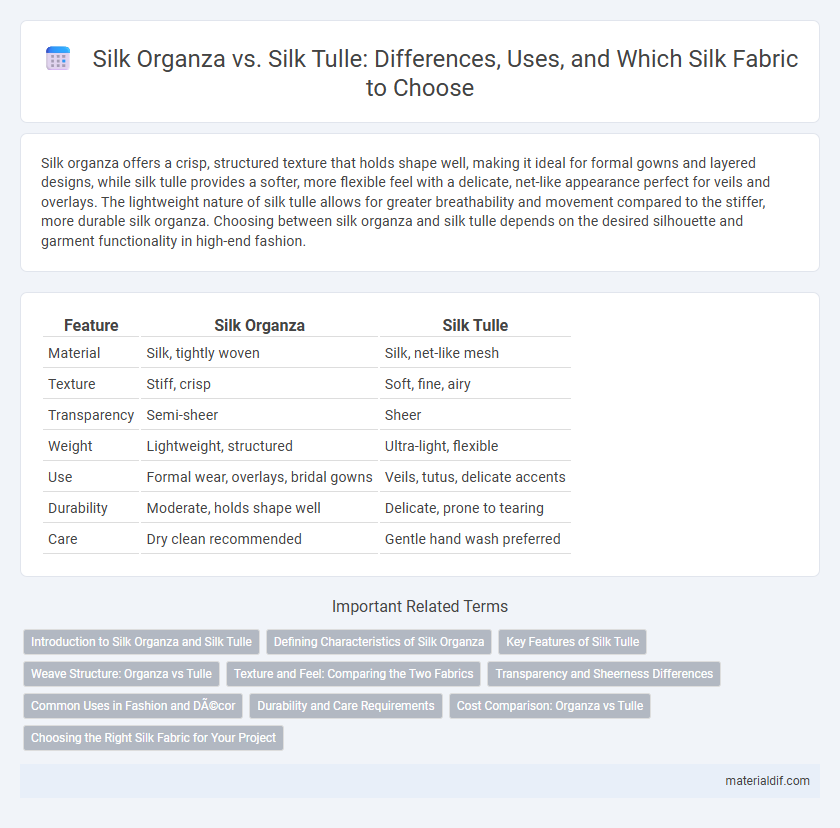Silk organza offers a crisp, structured texture that holds shape well, making it ideal for formal gowns and layered designs, while silk tulle provides a softer, more flexible feel with a delicate, net-like appearance perfect for veils and overlays. The lightweight nature of silk tulle allows for greater breathability and movement compared to the stiffer, more durable silk organza. Choosing between silk organza and silk tulle depends on the desired silhouette and garment functionality in high-end fashion.
Table of Comparison
| Feature | Silk Organza | Silk Tulle |
|---|---|---|
| Material | Silk, tightly woven | Silk, net-like mesh |
| Texture | Stiff, crisp | Soft, fine, airy |
| Transparency | Semi-sheer | Sheer |
| Weight | Lightweight, structured | Ultra-light, flexible |
| Use | Formal wear, overlays, bridal gowns | Veils, tutus, delicate accents |
| Durability | Moderate, holds shape well | Delicate, prone to tearing |
| Care | Dry clean recommended | Gentle hand wash preferred |
Introduction to Silk Organza and Silk Tulle
Silk organza is a thin, plain weave fabric known for its crisp texture and sheer appearance, often used in eveningwear and bridal gowns for its elegant structure. Silk tulle, by contrast, is a fine netting fabric characterized by its lightweight, delicate feel and stretchy nature, commonly utilized in veils and overlays. Both fabrics highlight the luxurious sheen of silk but differ significantly in texture and application.
Defining Characteristics of Silk Organza
Silk organza is a lightweight, sheer fabric known for its crisp texture and smooth finish, offering a structured yet delicate appearance ideal for elegant garments and overlays. This fabric features a plain weave with a slight stiffness that allows it to hold shapes and create volume without the bulk commonly associated with heavier textiles. Unlike silk tulle, which is softer and more flexible with a net-like structure, silk organza provides a luminous sheen and durability suited for formalwear and intricate detailing.
Key Features of Silk Tulle
Silk tulle is a lightweight, sheer fabric characterized by its delicate net-like structure, offering exceptional breathability and a soft, airy texture ideal for overlay and decorative accents. It features a fine mesh weave that provides flexibility and subtle stretch, making it perfect for intricate designs in bridal wear and evening gowns. Unlike silk organza, silk tulle possesses a more transparent quality and greater drape, enhancing its suitability for layering and creating ethereal, voluminous silhouettes.
Weave Structure: Organza vs Tulle
Silk organza features a plain weave structure, resulting in a crisp, lightweight fabric with a smooth surface and slight sheen, ideal for structured garments. Silk tulle, on the other hand, has a hexagonal mesh weave that creates a delicate, airy texture with a net-like appearance, commonly used for veils and overlays. The tighter weave of organza provides more durability and body, while the open mesh of tulle offers softness and flexibility.
Texture and Feel: Comparing the Two Fabrics
Silk organza offers a crisp, sheer texture with a slightly stiff hand, providing structure and a delicate shimmer ideal for formalwear and bridal gowns. In contrast, silk tulle is softer with a fine, net-like weave, creating a lightweight, airy feel that drapes fluidly and enhances volume without stiffness. The choice between silk organza and silk tulle depends on the desired garment silhouette and tactile experience, balancing firmness versus softness in the fabric's texture.
Transparency and Sheerness Differences
Silk organza features a crisp texture with higher opacity, offering moderate transparency suitable for structured garments and overlays. Silk tulle is ultra-fine and net-like, providing exceptional sheerness and delicate transparency, ideal for ethereal designs and intricate layering. The key contrast lies in silk organza's sturdier weave versus silk tulle's lightweight mesh, impacting the level of light passage and visual delicacy.
Common Uses in Fashion and Décor
Silk organza is commonly used in bridal gowns and evening wear due to its crisp texture and elegant sheen, providing structured silhouettes and delicate overlays. Silk tulle, known for its fine, lightweight mesh, is favored for creating voluminous skirts, veils, and decorative accents in fashion, as well as soft, airy curtains and decorative drapes in home decor. Both fabrics enhance designs with their unique textures, but organza lends a more polished, crisp appearance while tulle offers a whimsical, ethereal quality.
Durability and Care Requirements
Silk organza boasts greater durability compared to silk tulle, making it more resistant to snags and tears, which suits garments requiring structure and longevity. Its tighter weave demands gentle hand washing or professional dry cleaning to maintain fabric integrity, while silk tulle's delicate mesh composition requires even more careful handling to prevent damage. Proper storage away from direct sunlight and humidity preserves both fabrics, but silk organza typically withstands regular wear and care better than silk tulle.
Cost Comparison: Organza vs Tulle
Silk organza generally commands a higher price than silk tulle due to its denser weave and more labor-intensive production process. The durability and lustrous finish of silk organza contribute to its premium cost, making it more suitable for high-end fashion and bridal wear. In contrast, silk tulle is lighter and less costly, offering a budget-friendly option for delicate overlays and decorative accents.
Choosing the Right Silk Fabric for Your Project
Silk organza offers a crisp, sheer texture with a structured finish ideal for tailored designs and voluminous silhouettes, while silk tulle delivers a lightweight, delicate mesh perfect for layering and soft, ethereal effects. Selecting the right silk fabric depends on your project's needs for transparency, stiffness, and drape, as organza maintains shape and adds architectural form, whereas tulle provides airy softness and intricate detailing. Understanding the fiber weave and weight differences between silk organza and silk tulle ensures optimal fabric performance and aesthetic appeal in fashion or decor applications.
Silk organza vs Silk tulle Infographic

 materialdif.com
materialdif.com